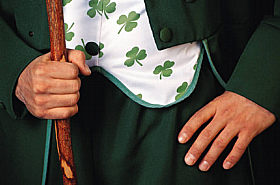Saint Patrick's Day
Saint Patrick’s Day is no longer just about a Feast Day for the Patron Saint of Ireland. This day has become more of a celebration of the Irish themselves. And in the United States, this is a huge step.
When the Irish first flooded into the New World, they were treated horribly, depicted in newspapers as drunken dancing monkeys, and even death incarnate. It was widely believed that the Irish brought disease and famine, yet after some time, the Irish community realized that their mass numbers meant they had influence, and that’s what they did. The Irish-Americans stepped up and changed their situation in the United States. Now the influence can be seen all over the world from politics to fantasy novels. There is a little Irish in us all.

Shamrocks everywhere for Saint Patrick's Day.
As a daughter of an immigrant of Irish descent, St. Patrick’s Day was a large part of my growing up. Even today, I incorporate my family’s traditions into my children’s upbringing. We set traps to catch leprechauns, so far we have only managed to snare a hat, and we bake breads and cookies and dye anything we can, without getting in trouble, green.
My children draw shamrocks to help decorate our festive table. The shamrock is an important part of the Irish celebration. Three is a magical number and it is thought the St. Patrick had used the shamrock to illustrate the Father, Son and Holy Spirit. But the three also represents the virgin, mother and crone, Love, Valor and Wit as well as Faith, Hope and Charity. In just the three leaves of the Shamrock, you can see why St. Patrick’s Day is now a secular celebration instead of only a Catholic Holiday.
Decorate your home and yourself in green, proclaim you are Irish for a day and feast in honor of the Emerald Isle with a few tradition dishes.
Corned beef and cabbage is the Irish-American version of the traditional Irish boiled bacon and cabagge. When the Irish immigrants came to the United States, they found some foods were more abundant and cheaper than in Ireland, so their recipes changed to some extent.
The quickest way to feel Irish, besides some green dyed beer, is making brown soda bread to be dipped into the traditional Irish stew. There are many variations of this traditional stew. Many families have different tastes. The Phelan clan enjoys ham instead of lamb and we add chickpeas to the mix, while only seasoning with pepper. Corned beef and cabbage is a traditional Easter food, Irish-Americans have now linked this food to Saint Patrick’s Day. For dessert you can’t go wrong with an everyday bread pudding or apple and blackcurrant pie.
Enjoy your day of pinching, drinking and eating and don't forget your Kiss me I'm Irish buttons at home.
Saint Patrick's Day is observed by the Catholic Church in honor of Saint Patrick, Ireland's patron saint, and is celebrated on the day of his death.
Something new
Irish recipes for inspiration.
Start a Saint Patrick's Day potluck brunch with friends and family. Have everyone to bring one very Irish dish and a shiny coin. You can hide the coins and have the kids looking for the leperchauns treasure.
No kids? Organize games and the winner takes it all.
What about line dancing?
